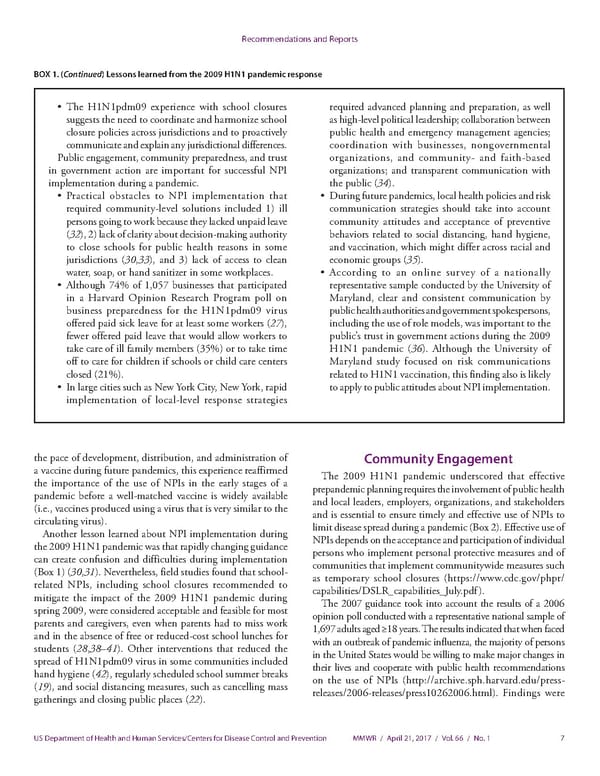Recommendations and Reports BOX 1. (Continued) Lessons learned from the 2009 H1N1 pandemic response • The H1N1pdm09 experience with school closures required advanced planning and preparation, as well suggests the need to coordinate and harmonize school as high-level political leadership; collaboration between closure policies across jurisdictions and to proactively public health and emergency management agencies; communicate and explain any jurisdictional differences. coordination with businesses, nongovernmental Public engagement, community preparedness, and trust organizations, and community- and faith-based in government action are important for successful NPI organizations; and transparent communication with implementation during a pandemic. the public (34). • Practical obstacles to NPI implementation that • During future pandemics, local health policies and risk required community-level solutions included 1) ill communication strategies should take into account persons going to work because they lacked unpaid leave community attitudes and acceptance of preventive (32), 2) lack of clarity about decision-making authority behaviors related to social distancing, hand hygiene, to close schools for public health reasons in some and vaccination, which might differ across racial and jurisdictions (30,33), and 3) lack of access to clean economic groups (35). water, soap, or hand sanitizer in some workplaces. • According to an online survey of a nationally • Although 74% of 1,057 businesses that participated representative sample conducted by the University of in a Harvard Opinion Research Program poll on Maryland, clear and consistent communication by business preparedness for the H1N1pdm09 virus public health authorities and government spokespersons, offered paid sick leave for at least some workers (27), including the use of role models, was important to the fewer offered paid leave that would allow workers to public’s trust in government actions during the 2009 take care of ill family members (35%) or to take time H1N1 pandemic (36). Although the University of off to care for children if schools or child care centers Maryland study focused on risk communications closed (21%). related to H1N1 vaccination, this finding also is likely • In large cities such as New York City, New York, rapid to apply to public attitudes about NPI implementation. implementation of local-level response strategies the pace of development, distribution, and administration of Community Engagement a vaccine during future pandemics, this experience reaffirmed The 2009 H1N1 pandemic underscored that effective the importance of the use of NPIs in the early stages of a prepandemic planning requires the involvement of public health pandemic before a well-matched vaccine is widely available and local leaders, employers, organizations, and stakeholders (i.e., vaccines produced using a virus that is very similar to the and is essential to ensure timely and effective use of NPIs to circulating virus). limit disease spread during a pandemic (Box 2). Effective use of Another lesson learned about NPI implementation during NPIs depends on the acceptance and participation of individual the 2009 H1N1 pandemic was that rapidly changing guidance persons who implement personal protective measures and of can create confusion and difficulties during implementation communities that implement communitywide measures such (Box 1) (30,31). Nevertheless, field studies found that school- as temporary school closures (https://www.cdc.gov/phpr/ related NPIs, including school closures recommended to capabilities/DSLR_capabilities_July.pdf). mitigate the impact of the 2009 H1N1 pandemic during The 2007 guidance took into account the results of a 2006 spring 2009, were considered acceptable and feasible for most opinion poll conducted with a representative national sample of parents and caregivers, even when parents had to miss work 1,697 adults aged ≥18 years. The results indicated that when faced and in the absence of free or reduced-cost school lunches for with an outbreak of pandemic influenza, the majority of persons students (28,38–41). Other interventions that reduced the in the United States would be willing to make major changes in spread of H1N1pdm09 virus in some communities included their lives and cooperate with public health recommendations hand hygiene (42), regularly scheduled school summer breaks on the use of NPIs (http://archive.sph.harvard.edu/press- (19), and social distancing measures, such as cancelling mass releases/2006-releases/press10262006.html). Findings were gatherings and closing public places (22). US Department of Health and Human Services/Centers for Disease Control and Prevention MMWR / April 21, 2017 / Vol. 66 / No. 1 7
 Community Mitigation Guidelines to Prevent Pandemic Influenza Page 8 Page 10
Community Mitigation Guidelines to Prevent Pandemic Influenza Page 8 Page 10